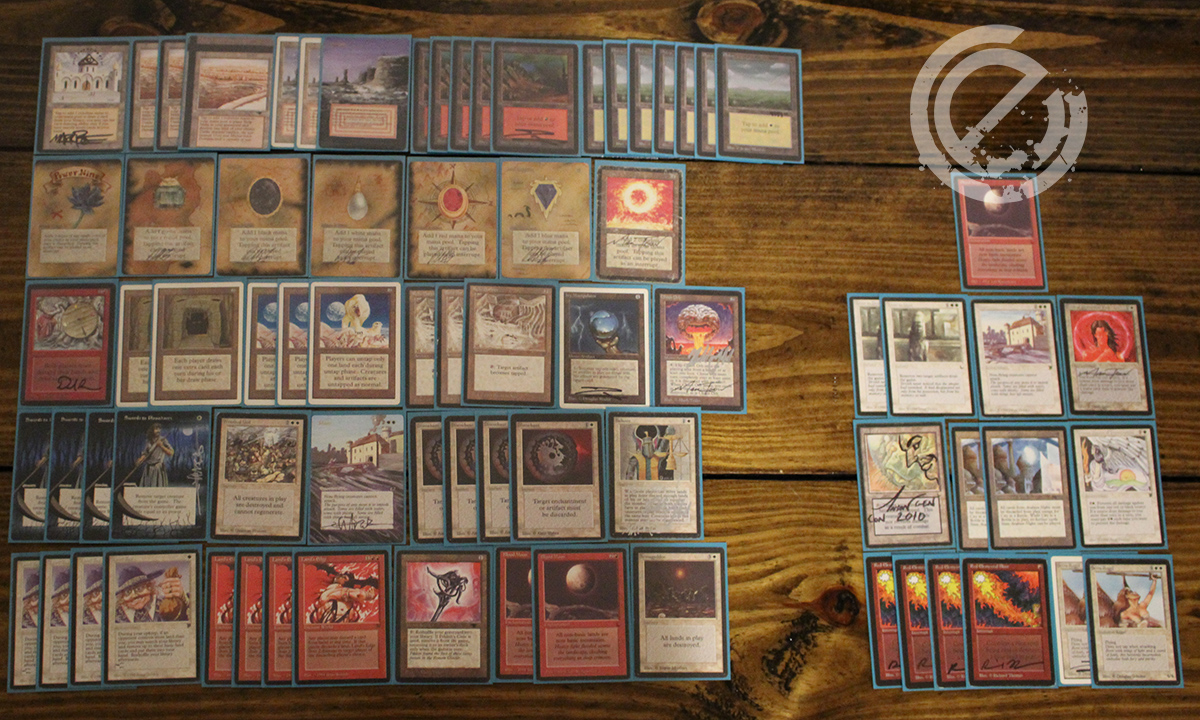Welcome to our second installment on Old School 93-94 Magic decks. We’ll take a look at a Land Tax + Land’s Edge combo deck, which I recently piloted in a friendly Old School Magic get together in Chicago (IL, USA).
This deck is inspired by two other decks before it. The first is an old deck that was featured in InQuest magazine in 1995, in the “Killer Decks Spotlight,” aptly titled “The Land’s Edge Deck.”
The Land’s Edge Deck, featured in InQuest Magazine
| Business (37) 4 Land Tax 4 Land’s Edge 2 Circle of Protection Red 2 Armageddon 1 Balance 3 Disenchant 4 Lightning Bolt 4 Swords to Plowshares 2 Wrath of God 1 Ivory Tower 2 Library of Leng 2 Reverse Damage 1 Skull of Orm 1 Wheel of Fortune 4 Serra Angel Mana Sources (23) 1 Mox Pearl 1 Mox Ruby 4 Plateau 5 Mountain 12 Plains |
As the Killer Decks Spotlight notes:
HOW IT WORKS
Simple: let your opponent get more lands than you, and use the Land Tax to stock up on basic lands. If you get a Library of Leng out, go for three lands a turn. Use the Serra and Lightning Bolts for efficient damage, and keep your opponent’s creatures at bay with Swords to Plowshares and Wrath of God. When you’ve got several lands in your hand, throw down a Land’s Edge and slam your opponent with all those excess lands in your hand.VARIANT DECK CONSTRUCTION
There’re plenty of ways to make this deck. All you really need are Land’s Edge, Land Tax, and Library of Leng. The rest is completely arbitrary. Just remember that you should never have more than five lands in play — less if you can get away with it.
As InQuest noted, the deck is focused on filling your hand with lands via Land Tax (while also simultaneously thinning your deck), and then killing your opponent, usually by discarding a bunch of the aforementioned lands to Land’s Edge.
The second inspiration for creating this deck for a recent Old School get-together was the legendary Tax-Rack deck from Extended. Randy Buehler ended up winning the 1998 North American Extended Championship with this breakout deck:
Tax Rack, by Randy Buehler – 1st Place 1998 North American Extended Championship
| Business (38) 3 Disenchant 2 Firestorm 4 Land Tax 4 Lightning Bolt 3 Scroll Rack 4 Swords to Plowshares 4 Tithe 2 Gorilla Shaman 4 Savannah Lions 4 Soltari Priest 4 White Knight Mana Sources (22) 4 Mox Diamond 4 Wasteland 1 Kjeldoran Outpost 4 Plateau 1 Savannah 8 Plains | Sideboard (15) 3 Aura of Silence 1 Disenchant 2 Gaea’s Blessing 2 Honorable Passage 3 Pyroblast 2 Sand Golem 2 Suleiman’s Legacy |
This deck was radically different than the Land’s Edge deck above, but there are some interesting lessons to learn from it. It cheated on mana sources (playing only 22 total, which could be found with Land’s Edge and Tithe), and used Land Tax to grab tons of lands to not only thin the deck, but also to eventually kill the opponent. Buehler utilized Scroll Rack (not available in 93-94 Magic) with Land Tax to generate huge card advantage and card quality, but instead of killing with Serra Angel and Land’s Edge, Randy used White Weenie-type creatures (all costing 1-2 mana) and Firestorm (which could be supplemented by the lands grabbed with Land Tax).
Both of these decks used Land Tax as the engine to ultimately fuel what could be a large amount of direct damage, fused together creatures as an additional source of damage. When designing my Old School 93-94 deck, I wanted to see if I could focus on the combo, while controlling the battlefield, and foregoing creatures altogether. Here’s my first draft that I brought to battle:
Tax Edge 20143Q 1.0, by Jaco 09-04-2014
| Business (34) 4 Land Tax 4 Land’s Edge 1 Feldon’s Cane 4 Swords to Plowshares 1 Moat 1 Wrath of God 4 Disenchant 1 Balance 1 Chaos Orb 2 Blood Moon 1 Armageddon 1 Wheel of Fortune 2 Howling Mine 3 Winter Orb 3 Relic Barrier 1 Icy Manipulator Mana Sources (26) 1 Black Lotus 1 Mox Emerald 1 Mox Jet 1 Mox Pearl 1 Mox Ruby 1 Mox Sapphire 1 Sol Ring 1 Library of Alexandria 3 Strip Mine 3 Plateau 5 Mountain 7 Plains | Sideboard (15) 1 Blood Moon 2 City in a Bottle 1 Maze of Ith 1 Moat 1 Circle of Protection Red 1 Greater Realms of Preservation 2 Dust to Dust 2 Serra Angel 4 Red Elemental Blast |
The decklist is above, and the initial version of the deck is shown in the photograph below for your enjoyment (click on photo to zoom in new window).
Constructing Tax Edge
There are a number of ways this deck can be constructed. In the decks above there are anywhere from 4 to 14 creatures present. Do you fuse the Land Tax engine to a weenie and direct damage strategy with Lightning Bolts, and then not rely as heavily on Land’s Edge as a finisher? Do you play a few Serra Angels, control the board, and rely more heavily on Land’s Edge?
I chose to focus on the combo kill itself, keeping it only two colors consistency, and also build in a board-controlling aspect. Let’s look at some very specific elements of what I chose to do in this version (which will likely change in the future each time I play it).
The Land Tax + Land’s Edge Engine
Land Tax is really what makes this deck as powerful as it is. Not only does it fill your hand to ultimately kill your opponent with Land’s Edge, but it also allows you to mulligan more aggressively to a good hand. I will often mulligan to 6 or even 5 with this deck, looking for combo cards and especially Land Tax. If you don’t have Land Tax in hand, Wheel of Fortune and Howling Mine are also along for the ride to dig for more lands, as well as any missing part of the combo engine.
Land’s Edge is a very unique card in the 93-94 format, as it is one of the few cards that allows for significant repeatable direct damage, at a relatively efficient 3 mana. One thing to keep in mind is that it not quite the same as Seismic Assault, which has seen plenty of play over the past few years in Extended and Legacy decks. Seismic Assault allows you to discard a land to do 2 damage to any target, but Land’s Edge allows either player to discard a land to do 2 damage to target player (so you cannot do damage to creatures, which is important to note). So in some cases you will want to get Land’s Edge out on the battlefield as soon as possible to prevent it from being countered or discarded, while in other cases you may want to hold it so it doesn’t get Disenchanted, or so the opponent doesn’t have as much of an opportunity to discard their own lands to damage you.
One other small but important point about Land’s Edge is that the card type is ‘Enchant World.’ This is an old card type that is no longer printed, but it operates as a type of Legendary Enchantment, in that only one type of Enchant World can be in play at any one time, and a newly played Enchant World will knock out an existing Enchant World on the battlefield. Other notable Enchant World cards in Old School 93-94 are The Abyss, Nether Void, Concordant Crossroads, and In the Eye of Chaos.
The final definite part of the engine is Feldon’s Cane. This was actually restricted in Type I from 05/02/1994 until 10/01/1997 because of the recursive ability it could provide, which was deemed too powerful in combo decks of the era. In this deck it allows you to recycle your deck, and most importantly, shuffles lands back into your deck if you need more fodder for Land Tax and/or Land’s Edge. Feldon’s Cane also allows you to play a very long game with the deck, and potentially deck your opponent. I had this come up in a game recently against a Stasis control deck (which also played Howling Mine), and this led to my opponent conceding with about 7 cards left in his library before being decked. I only played 1 copy in the main deck in this initial build of the deck because I only owned a single one, but in the future versions of Tax Edge I will probably play more copies main, as it can often be very good, and can serve as a more central component of the deck’s engine. This also provides redundancy, as you have more ways to cycle through your deck after it is starting to thin out, and keep drawing threats as the game goes long, even if they have been countered, discarded, or destroyed.
Other important considerations as part of the engine of the deck are Library of Leng, which allows you to have no maximum hand size and shields against discard (all for a single colorless mana), and Ivory Tower, which allows you to gain life for every card in hand above 4 (again, for a single colorless mana). These work in concert with each other, as well as with Land Tax, and can help to fight against pesky Black Vises and aggressive strategies by buffering your life total.
Going (Semi) Creatureless
By not playing any creatures (at least in the main deck), we create a lot of dead draws for our opponents. This does limit our initial avenue of attack, but the relative card advantage gained by creating so many dead cards in our opponent’s decks was a trade-off I was willing to make when initially constructing this brew.
There are a pair of Serra Angels in the sideboard, which is a good place for them. This allows you to bring in a serious threat if you want to speed your clock up, or if you expect your opponent to side out all of their removal. It also lets you play the guessing game with your opponent. Will they board out all of their creature removal? Will you bring in Serra Angel, and should they leave in removal if they know you are? If so, how much removal will they leave in, creating potentially dead draws if you either don’t bring in Serra Angel, or haven’t yet drawn it? There are small but important advantages to be gained with the opportunities that this brings.
Controlling the Battlefield
In this build I’ve chosen to include more controlling elements, rather than aggressive creature elements, for the reasons mentioned above. To control the battlefield we’ve got a mix of the best spell-based removal, coupled with some permanent-based effects to clog up the landscape.
There is a full suite of Swords to Plowshares and Disenchants, as well as opportunistic singletons like Moat, Wrath of God, and Armageddon. Blood Moons are also in tow to really disrupt or entirely shut down some of the decks that rely very heavily on a rainbow-like manabase.
There are a decent number of support artifacts as well. Winter Orb helps to disrupt the opponent and slow the game down long enough for you to assemble your combo, while Relic Barrier and Icy Manipulator can do the same. They also have the benefit of turning off Winter Orb by tapping it on your opponent’s end step (at Eternal Central we recommend this original errata for Winter Orb, to play as it was originally intended).
Likewise, you may have noticed the presence of Howling Mine in the deck as well. This can sometimes be a double-edged sword, as the extra cards drawn may provide your opponent with more threats, but it is also likely to provide you more answers. Howling Mine may also provide you more combo parts in short order (and lands to discard for damage), and like Winter Orb, can be made into a 1-sided advantage (or disadvantage for your opponent) by tapping it at the opportune time with Relic Barrier or Icy Manipulator.
Most of these support cards are relatively low casting cost, to ensure that you don’t have to run a lot of lands out to cast them. The few that do cost more than 2 mana are usually very high impact.
A very strong case can be made for Lightning Bolt in this deck, not only to provide additional reach to close the game out, but to serve as additional creature removal. Swords to Plowshares is slightly preferred, as it is the most efficient creature removal in the format and can handle larger creatures (Djinns, Efreets, Su Chi, etc.), but the downside is that your opponent gains life (requiring more damage to ultimately kill them). Future versions of this deck will likely see 2-4 copies of Lightning Bolt between the main deck and sideboard.
Choosing Your Manabase
The oldest version of this deck chose to ignore most of the fast mana available in the format, in order to secure room for more basic lands. This allows you to more frequently activate Land Tax, and most likely have more lands to discard to Land’s Edge as the game goes on.
In my version you’ll notice that I’ve gone the opposite approach, and have the full complement of Moxen and Sol Ring. This decision was made to allow the deck to operate with fewer lands in play, and to power out cards like Land’s Edge, Moat, Armageddon, and the artifact disruption at a quicker pace. The trade-off is that you obviously don’t have as many lands to draw and search up with Land Tax, which you will ultimately discard to Land’s Edge. Between careful play and the recursion ability of Feldon’s Cane I have found this balance to be struck so that I am still able to reliably kill my opponent with Land’s Edge without problem. When triggering Land Tax you may find up to 3 lands, and it is important that you calculate how your turn will play out with your draw step and how many cards you will have in hand, so you don’t end up needlessly discarding lands at the end of turn.
Building a Sideboard
When constructing a sideboard for this deck I wanted to address a few key opposing strategies. The first was very aggressive decks. Cards like Lightning Bolt, Maze of Ith, Greater Realms of Preservation, and Circle of Protection: Red, Moat, and additional Wrath of Gods allow you to be as punitive as you want towards these decks. There are many tools, and these are but a few of which I’ve chosen to use in this version of the deck. Another important thing to note that may come up if you play this deck is that COP: Red and Greater Realms of Preservation allow you to shield yourself from your opponent’s activations of Land’s Edge if you wish.
The next couple of strategies that I wanted help against was the very artifact-heavy control decks and artifact-aggro decks, and Dust to Dust is very efficient in combating these. Shatter, Shatterstorm, and even Damping Field are all playable options for this, but I felt that Dust to Dust was probably best suited for the challenge in this deck, as it’s always a 2-for-1, and there’s no collateral damage to my own artifacts (unlike Shatterstorm or Damping Field).
The final key strategy I wanted to address out of the sideboard was that of the blue-heavy control decks with tons of counterspells, and the turbo-Amnesia decks. Red Elemental Blast is so efficient for what it does, and really helps force through your key threats when you need (like a well-timed Armageddon, or the lethal Land’s Edge). Being able to play aggressively and reliably have the ability to counter your opponent’s Counterspell or Amnesia is huge in Old School Magic.
The rest of the sideboard (aside from the aforementioned Serra Angel) was filled with tools that are just good against a variety of decks. Blood Moon is obviously a bomb against the rainbow control decks and 3+ color aggro decks, and City in a Bottle is a very good tool that can knock out multiple Kird Apes, Djinns, Efreets, and Cities of Brass, all for the measly price of 2 colorless mana!
This sideboard can and obviously should change depending on what you think is best suited for your local area, and as you can see above, Red and White provide some of the most powerful and efficient tools for this task.
Playing RW Tax Edge
The way I’ve built this deck with both the controlling elements and the narrow focus on the combo allows you to play fast and aggressively, or play slow and ploddingly, depending on what your opponent is doing, and depending on your opening hand. Below we’ll examine ten opening hands with the deck, and then we’ll look at the deck in action against a UW Stasis deck.
Eight Opening Hands with RW Tax Edge
Below are eight opening hands, exactly as I have drawn them from the deck, photographed for you to see, and decide along with me whether to keep the hand or not, and how we might approach the ensuing game with each hand.
Opening Hand 1
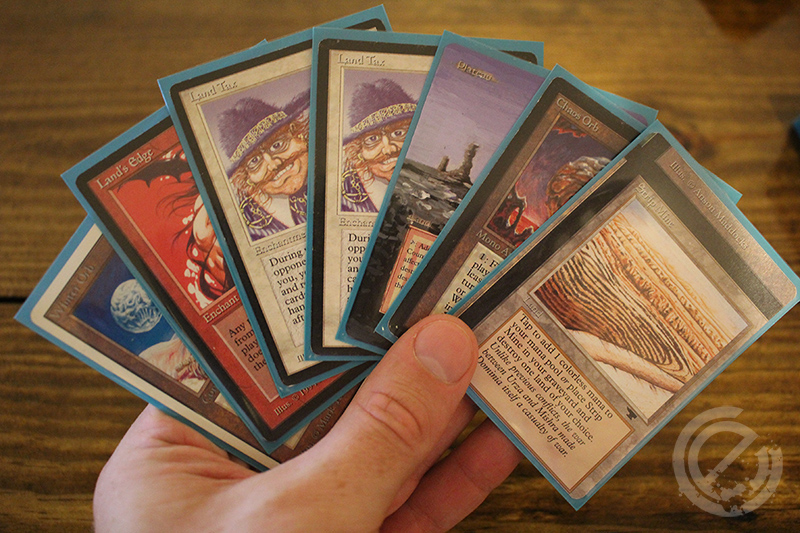
This hand is a snap keep. You have all of your combo parts, Plateau to cast Land Tax, a follow up Land Tax if the first gets countered or Disenchanted, and Strip Mine. Strip Mine is valuable here not only to disrupt your opponent, but also to bait them to play more lands to cast their spells (triggering your Land Tax), or even to Strip your own land if need be at some point to trigger Land Tax. Golden.
Opening Hand 2

This hand is mediocre, but probably a keep. You have multiple pieces of disruption in the form of Blood Moon, Strip Mine, and double Disenchant. You also have part of your combo, and can actually cast Blood Moon into Land’s Edge if need be (as the Strip Mine will be turned into a Mountain).
Opening Hand 3

Not a spectactular hand, but proabably a keeper. You have double Land’s Edge, both colored mana, and Swords for early protection. I’d probably lead with Mountain here (fearing Strip Mine), and then deploy the Plains as need be in order to Swords a threat on sight.
Opening Hand 4
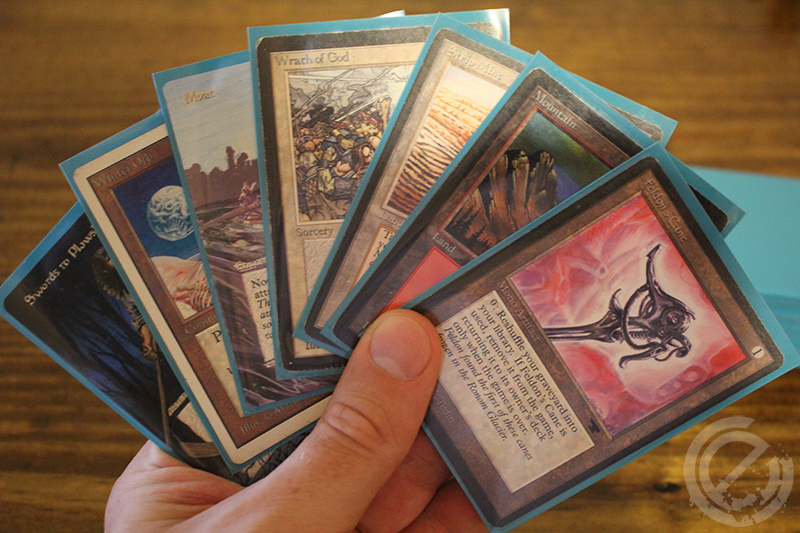
No Land Tax, no Land’s Edge, and no White mana. This is a pretty obvious mulligan, so let’s look at the next 6.
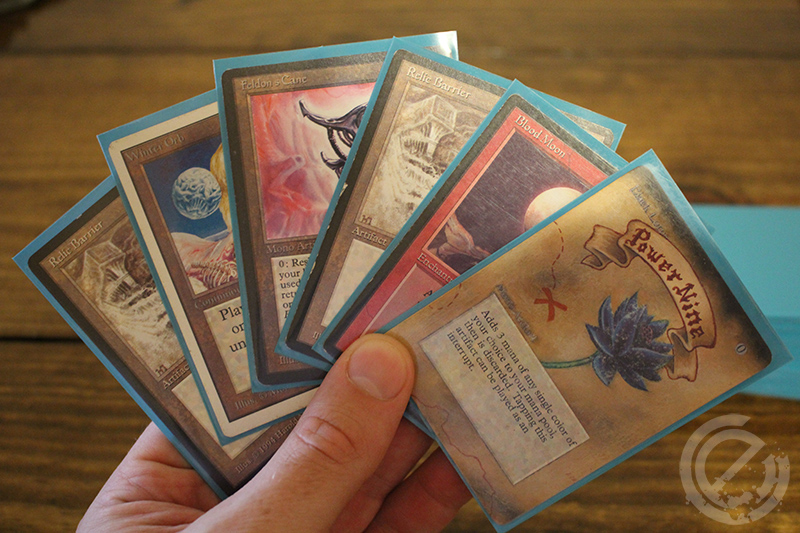
What appears to be an auto-mulligan at first blush is actually an interesting hand. We don’t have any mana sources, but if we know we’re playing against a 3-5 color deck with very few (if any) basic lands, Black Lotus into Blood Moon on the first turn can potentially be a back breaking play. On the other hand, if we’re playing against a 1-2 color deck this hand falls flat on its face. Let’s mulligan to the next 5.
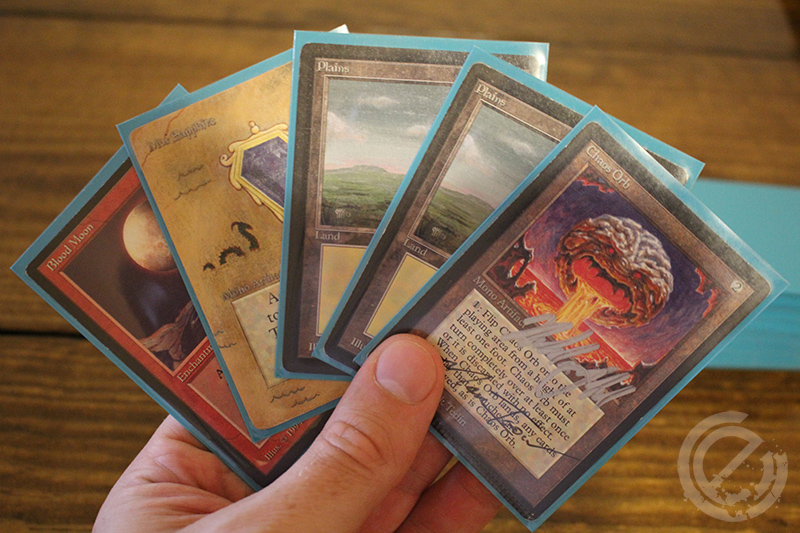
Lands, Blood Moon, and flexible removal in the form of Chaos Orb. This hand of 5 isn’t great by any means, but definitely keepable. Obviously how this hand plays out depends on what you draw, but I’d probably lead with just the basic Plains and pass, and then on the second turn play Sapphire and Plains into Chaos Orb, leaving a mana up. There’s no reason to play the Sapphire on the first turn (exposing it to removal or Relic Barrier), and you definitely want to avoid playing a Chaos Orb in any situation without leaving up mana to activate it. There’s too much risk that it will be destroyed without being able to use it, and it’s just not worth it. Chaos Orb is too valuable of a tactical asset.
Opening Hand 5
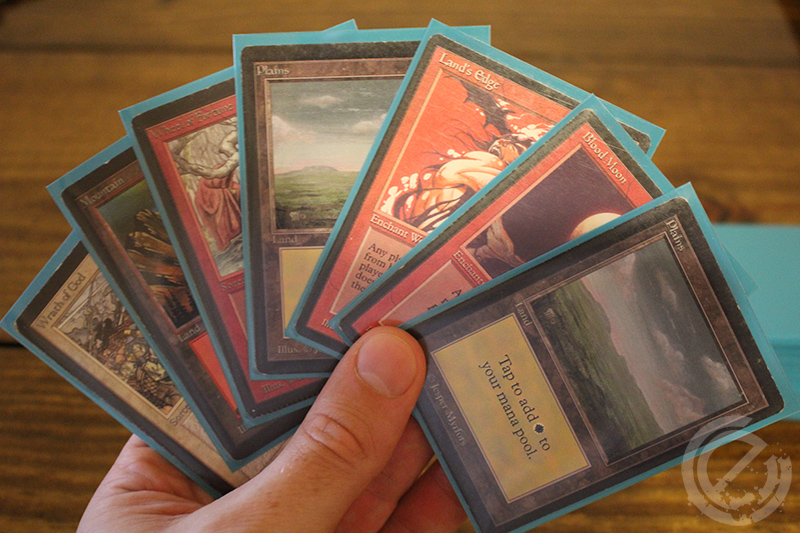
Land’s Edge, Blood Moon, Wrath of God, Wheel of Fortune, and good mana to cast basically everything in your deck. This hand is a keeper, and will play out differently than most of those above. You can deploy your lands each turn without having to worry about Land Tax early, and this will be a slow and controlling hand.
Opening Hand 6

This is a very good hand. You have the opportunity to play a first turn Mox Pearl into Land Tax, which is essentially guaranteed to trigger. There’s Disenchant, Winter Orb, and Icy Manipulator for disruption. This hand will likely play out very slowly, but if you had opening hands like this every time you’d win most of your games.
Opening Hand 7

Strip Mine is our only land, and while we have some good disruption and Land’s Edge, we can’t reliably cast anything important with the lack of colored mana. Let’s look at what a mulligan to 6 brings.

No mana sources at all make this an easy mulligan. Let’s hope for a better 5.
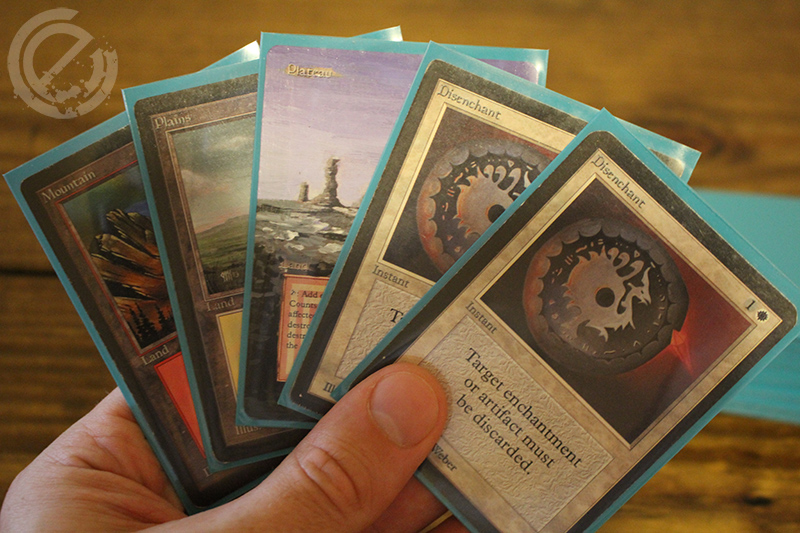
Disruption in the form of double Disenchant, and mana to cast almost everything in our deck. This is a weak 5, but good enough to prevent us from going to 4.
Opening Hand 8

Lots of disruption in this hand, and a Land’s Edge, but very weak mana. If we don’t get Strip Mined this hand is probably fantastaic, but this is a debatable keep, depending on what you think you’re playing against. In our area we allow unrestricted Strip Mines, so I’m fearful that Strip Mine will just destroy this hand and put us in bad shape. I’m going to mulligan to 6.
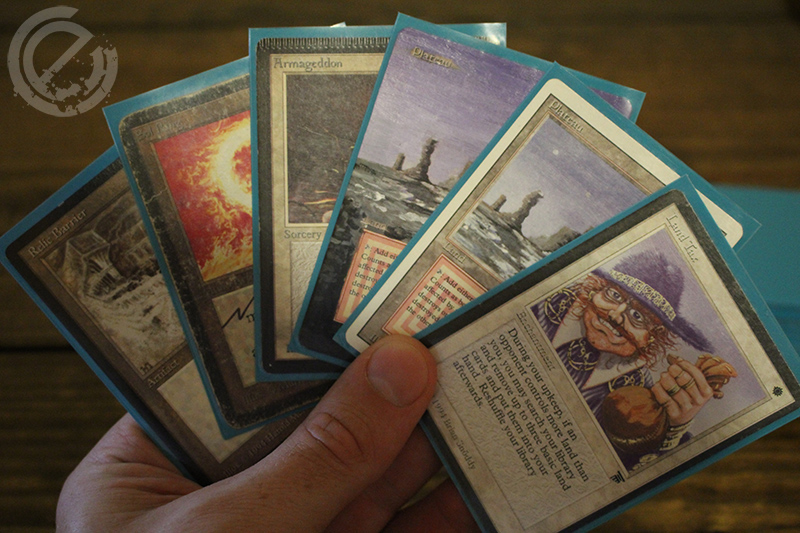
This hand has good mana, Land Tax, acceleration in the form of Sol Ring, and disruption in the form of Relic Barrier and Armageddon. This is a very good 6 card hand, so we’ll keep, and probably deploy Plateau into Sol Ring into Relic Barrier on the first turn. This allows us to deploy Land Tax more tactically on the second or third turn, when it’s more beneficial to us after our opponent has played more lands out. Armageddon can be quite devastating on its own, but should prove to be especially potent with how this hand will play out.
RW Land Tax in Action vs. UW Stasis
Below are a few pictures from sample games against my friend Danny Friedman’s UW Stasis Control deck during a recent impromptu German beer and Old School Magic Sunday night get together.
Game 1
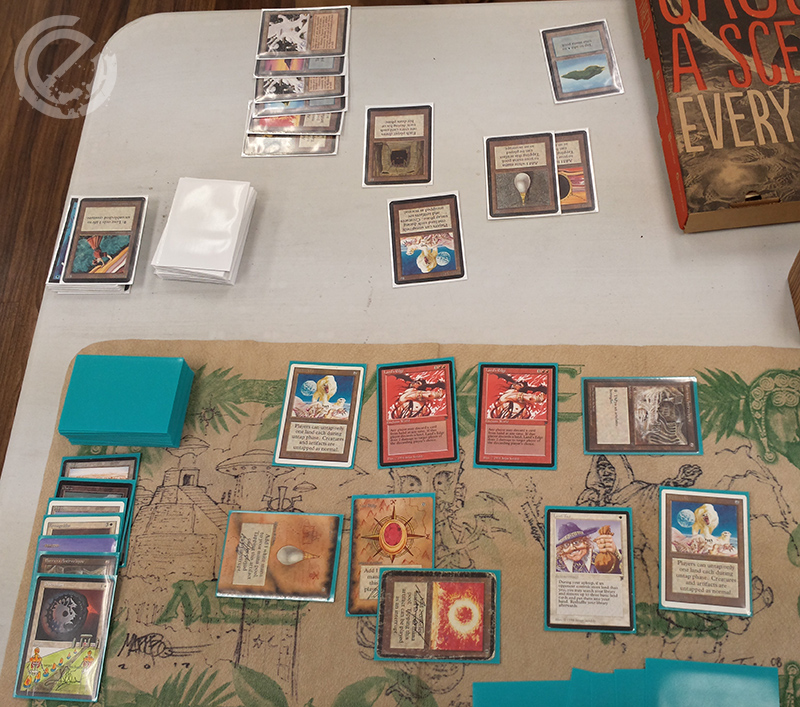
This photo illustrates what was essentially the end state for this game, but the game began by landing a first turn Land Tax, and then Strip Mining our opponent and locking down their artifact mana with Relic Barrier the first few turns. We ended up forcing through a Land’s Edge by either baiting with Armageddon, or actually resolving Armageddon, and then resolving the follow up kill spell (note the double Land’s Edge available from our hand).
Game 2
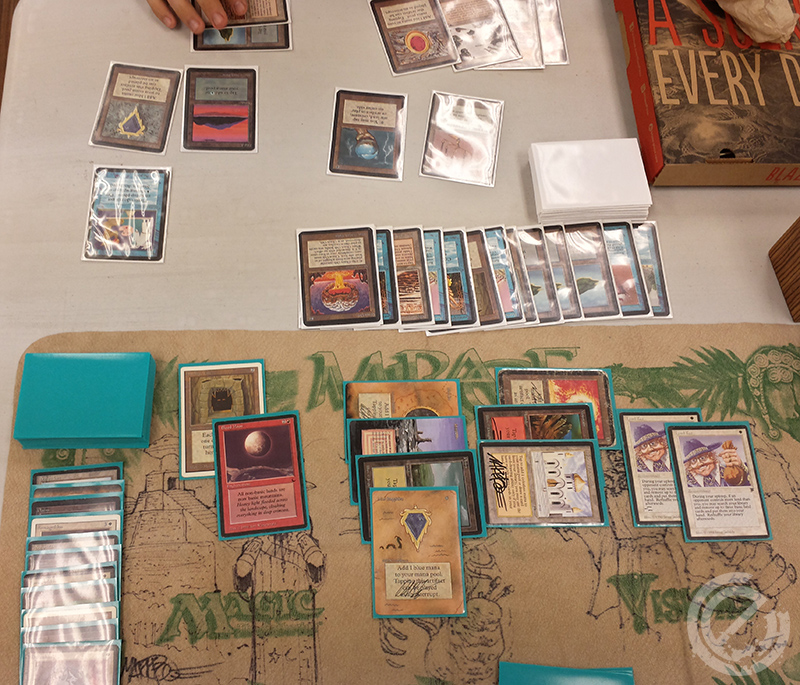
This is the middle of a very long and drawn out affair. We once again resolved an early Land Tax, Armageddon (blowing up a few of our opponent’s lands, but not totally devastating), and a late Blood Moon (shutting off multiple opposing Mishra’s Factories). Our opponent resolved Stasis and then was able to save it against 2 of our Disenchants, by Counterspelling one and Boomeranging it back to hand the second time, which allowed them to eventually drag the game out and kill us 15+ turns later with 2 Black Vises. We never saw (or were able to resolve) Land’s Edge this game before our mana was tied up indefinitely, leading to the loss.
Game 3
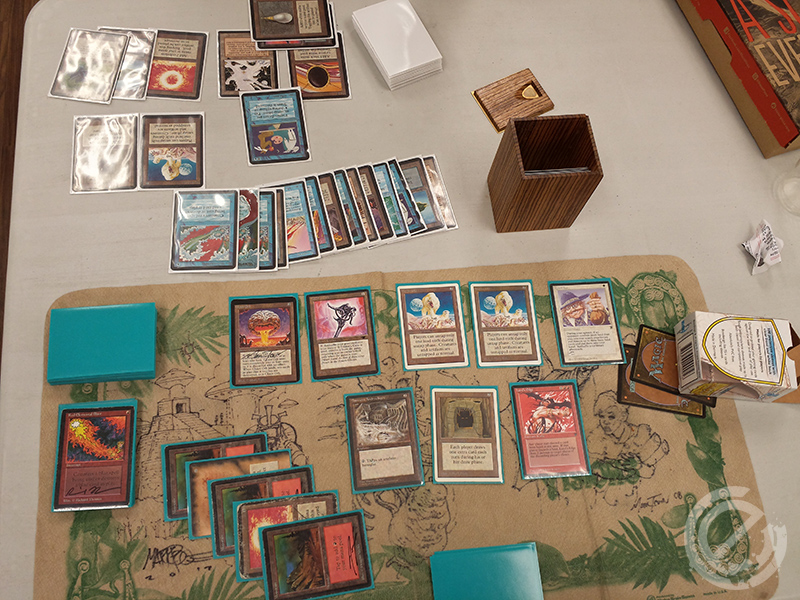
This was a back and forth affair that featured multiple Stasis resolutions and both players managing their resources through Winter Orb (seen on both sides of the table). An early Land Tax resolved, but it wasn’t until about 10 turns in when the drama got exciting. The second Land’s Edge was finally forced through with the help of a second Red Elemental Blast, and from there the outcome of the game was elementary. Once again Feldon’s Cane is lending a helping hand to ensure there are enough lands in the deck to provide damage with Land’s Edge.
Concluding Remarks
The Land Tax + Land’s Edge combo is a suitable engine to build a deck around. How you construct it is up to you, but the sample list above will hopefully be a nice starting point to illustrate some strategies and tactics that work well with each other. As I move forward I will look for ways to incorporate more Lightning Bolts and Feldon’s Canes probably, and perhaps more of a supplemental draw engine of sorts, but most of this existing framework of the deck is solid.
Good luck in your next Old School battle!


